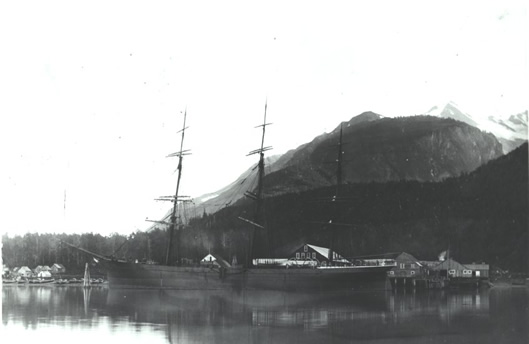
Close-up view of a large three-masted sailing ship moored in front of Pyramid Harbor Cannery, on a calm day. Cannery worker housing is visible to left of photo, 1898.
Southeast Alaska is a unique part of the world. Beautiful scenery and a relatively mild climate create a pleasing place to live. Bountiful life sustaining resources such as fish, berries and wildlife enticed the Indians, the first people in the region, to stay. Steep, rugged mountains and dense underbrush often made land travel a near impossibility in many places. The path of least resistance was–and even with the advent of air travel sometimes still is–water.
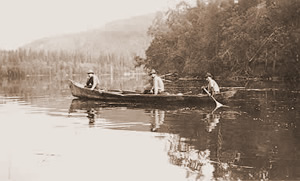
A dugout canoe plying still river waters.
The Tlingit people made large ocean-going canoes for trading, visiting neighboring villages and waging war. Today, state ferries, luxury cruise ships, the Coast Guard, fishing boats and other assorted vessels ply those same waters. Most communities in Southeast continue to rely heavily on marine transportation since interstate highways are found only in Haines, Skagway and Hyder. Juneau, Alaska’s state capital, is inaccessible by road.
The first known meeting of non-Native and Tlingit people took place in 1741 when two Russian ships set off to explore the land to the east. The St. Peter, under the command of Alexei Chirikof, anchored near the community of Yakutat, west of Haines. Two boats were sent ashore, neither of which was reported returning. Later expeditions fared much better as Spanish, English, Russians and Americans carried on brisk fur trading with the Tlingits — who incidentally were described as astute bargainers. The first steamship in the North Pacific, The Beaver, was built especially for travel up the Inside Passage. It was commissioned by the Hudson’s Bay Company whose traders steamed to the Chilkat River near Haines as late as 1865.
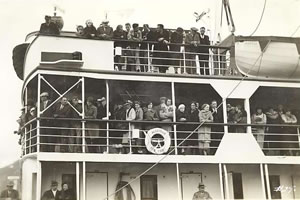
Tourist ship docked at Chilkoot Barracks (Fort Seward), 1936.
Regular monthly boat service from U.S. ports to Sitka began in 1867 following the purchase of Alaska from the Russians. Occupation troops were dispatched and cargo and mail soon followed. By 1875 several shiplines were making the voyage all the way up the Panhandle in spite of often-inhospitable waters and a treacherous coastline. The first tourists began booking passage as reports of unparalleled scenery were increasingly publicized. Eighteen hundred tourists visited the territory by ship during the summer of 1892.
By the turn of the century several events had caused tremendous increase in Southeast Alaskan marine travel: Presbyterian missions were established (1881 in Haines); fish canneries were built (1882 in Haines); and gold had been discovered in Alaska. The Inside Passage was a major route to overland staging areas for the gold fields.
In December of 1894, Charles E. Peabody and his associates founded the Alaska Steamship Company, which would eventually enjoy a near monopoly of freight and passenger service to Alaska as their fleet increased to 67 ships. Alaska Steam called at Haines, and many long-time residents have nostalgic memories of voyages on the line.
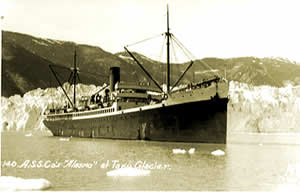
Alaska Steamship Company steamer “Alaska” at Taku Glacier.
The Alaska Steamship Company continued passenger service until 1954 when a combination of factors forced it into the freight business. Following W.W.II, The state’s population decreased and passenger planes began flying to Alaska. The end of an era was at hand as the gallant flotilla of passenger vessels disappeared from Alaska waters. Stiff competition (among other factors) eventually forced Alaska Steamship Company out of the freight business in 1971.
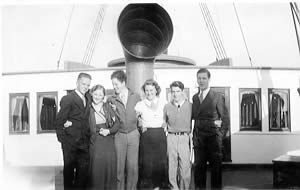
Harriet Sheldon (middle) greeting friends off a steamer.
Harriet Sheldon Brakken, daughter of Steve Sheldon, remembers the Alaska line clearly, having grown up in Haines during its operation. She and her sister, Elisabeth Hakkinen, Curator Emeritus of the Sheldon Museum and Cultural Center, traveled south to college onboard the ships. This is one of her recollections: “During our years of traveling to Seattle in the fall (1930-39) enroute to college and returning home each spring, Alaskan young people had the opportunity to get acquainted. Most of the canneries hired young men for summer help. They went to school at the same time and we all knew each other. At that time of year the ships made frequent stops at canneries, spending several hours loading and unloading. We would go down to the kitchen and get a lunch. Then off we went on some beautiful trails along the Inside Passage.”
Elisabeth recalls the days of Alaska Steam’s Christmas ship: “One charming custom which disappeared with the Alaska Steamship Company’s passenger and freight service was the annual Christmas ship. If it docked during school hours, teachers and students went to greet it together. No more school was expected that day, and the children usually went home from the dock with their parents. The ship was gaily decorated with lights and flags galore, and the ship’s musicians would be playing carols all the time they were in port. Santa himself would be aboard holding court. He had a box of gifts on each side of his chair – on one side were things for girls, and on the other were the gifts for boys – each one carefully and gaily wrapped. An elf stood by and gave sprays of holly and mistletoe to all the ladies.
Here in Haines two military ships, the U.S. Harbor Boats Peterson and Captain James Fornance impacted both military and civilian life. Ostensibly the 125′ crafts supplemented mail and freight service to Fort Seward (called Chilkoot Barracks after 1923) and were used for recreation for the troops from1909-1932. However, civilians could also ride the boats for free, and a mingling of townsfolk and military personnel was achieved.
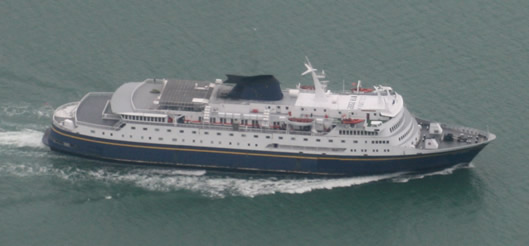
Alaska Marine Highway System ferry traveling along the Lynn Canal toward Haines, 2011.
Today, year round marine transportation is provided by the Alaska Marine Highway system– the ferries, locally known as “the big blue canoes.” The system has its roots here in Haines where, in 1948, two young local men, Steve Homer and Ray Gelotte, began the service with a converted LCT-Mark 6 landing craft. They christened it the MV Chilkoot, and carried people, freight and vehicles between Haines, Skagway and Tee Harbor, 18 miles north of Juneau. Their business was purchased by the Territory of Alaska in 1951 and grew, as the Alaska Marine Highway to nine ferries with service extended to Seattle. After 25 years of service, the southern terminus was relocated to Bellingham, Washington. A new ferry, the MV Kennicott, was added to the fleet in 1998 and in 2004 a catamaran, the MV Fairweather, began service between Juneau, Haines, & Skagway. Several private shuttles have been operating between the three ports since the mid-1990s.
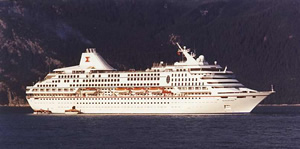
A cruiseship in the Lynn Canal.
Cruiseships are a common sight along the Lynn Canal. Tourism has become a staple industry in most Southeast Alaska towns. As many as five cruise ships dock in neighboring Skagway every day during the summer. Haines has an average of one or two cruise ships a week with smaller vessels docking throughout.
Click here for shipwrecks in the Lynn Canal and Juneau Area.
Barbara Waterbury 1987
updated by Blythe Carter 2003, 2013.
The Road to Nowhere
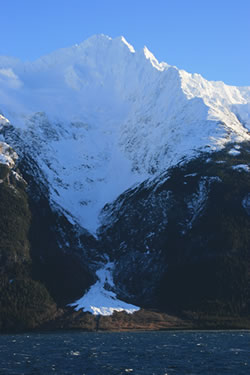
Avalanche along the Lynn Canal, 2011.
For many years the state has been pushing for a road along the Lynn Canal which would connect Juneau (the state capital) with Skagway and the rest of the continental United States and eliminate current ferry services in the area.
As of 2011, the proposed Juneau Access Road would consist of 51 miles of new road from Echo Cove (approximately 40 miles north of Juneau) to the Katzehin River via the east side of Lynn Canal, a new ferry terminal at the river 90 miles from Juneau rather than the existing terminal 13 miles from Juneau, and small shuttle ferries to Haines and Skagway.
According to an independent estimate undertaken by the state, the project will cost approximately a half-billion dollars not including cost increases that are likely when the terrain has been fully surveyed. On February 13, 2009, federal Judge John Sedwick of the Alaska District Court ruled that the existing Environmental Impact Statement for the project was inadequate because it failed to consider plans for improving and making use of the ferry infrastructure already in place as an alternative. In May of 2011, the 9th Circuit Court of Appeals upheld this ruling.
“The Federal Highway Administration and the Forest Service failed to look at the most obvious alternative, which is to improve access to Juneau using existing ferries,” SEACC Grassroots Attorney Buck Lindekugel said in a release. “Why should we build an expensive and unnecessary road — which will still require a ferry connection — when improved ferry schedules, fares and other service could meet community needs?”
Juneau supporters for the road argue that a road would secure Juneau as the capital city (since the capital has twice been voted to be moved nearer Anchorage, this is an ever-present fear in the minds of many Juneau residents that live in a city they feel would hardly exist without state bureaucratic presence); that the increased tourism via buses and RVs will boost Juneau’s economy; that a road would make Juneau the top sea port in Southeast Alaska; that it would provide more readily available healthcare to residents of Skagway and Haines, and allow Juneau residents to drive north instead of catching a ferry or plane.
Local supporters sight benefits including easier access to Juneau; lower costs for local merchants who ship from Juneau; new jobs in trucking, auto repairs and service, road maintenance, and accommodating Juneau visitors; more access to outdoor activities, and easier access for those traveling to work at the mine and other juneau jobs. The road could also provide emergency transportation when planes can’t fly and thereby save lives.
Local opponents of the road include the Haines Borough Assembly, the Haines Chamber of Commerce, many local business owners and residents of both Haines and Skagway, most of whom prefer improvements to the existing ferry service. Their reasons include the prohibitive cost of constructing and maintaining a road that crosses 58 avalanche shutes and that still relies on small shuttles; the likelihood that the road would be closed frequently in winter due to avalanches, mud slides, and heavy snowfall, effectively cutting off both Haines and Skagway from supplies and medical help; lost of income and jobs on the existing ferry system; the economical impact of “big city” shopping on local businesses; and the enviromental impact on salmon fisheries and other wildlife due to the construction of the road and increased human traffic.
The push for a road and the resultant contraversy is on-going.
Blythe Carter, 2013
Bibliography:
Tom Morphet, Chilkat Valley News “Borough, Chamber: Ferry, not canal road,” November 17th, 2011.
